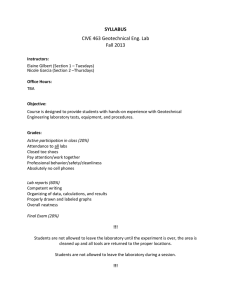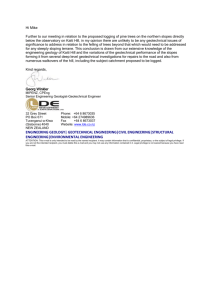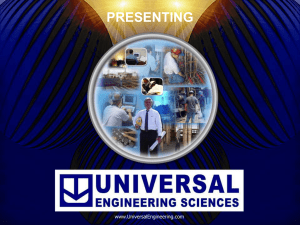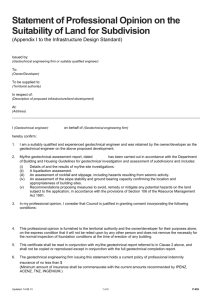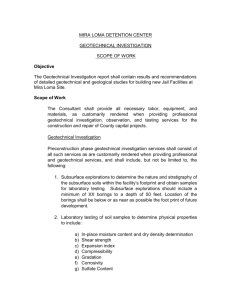Developing Re-Use Applications and Improving the Economic
advertisement
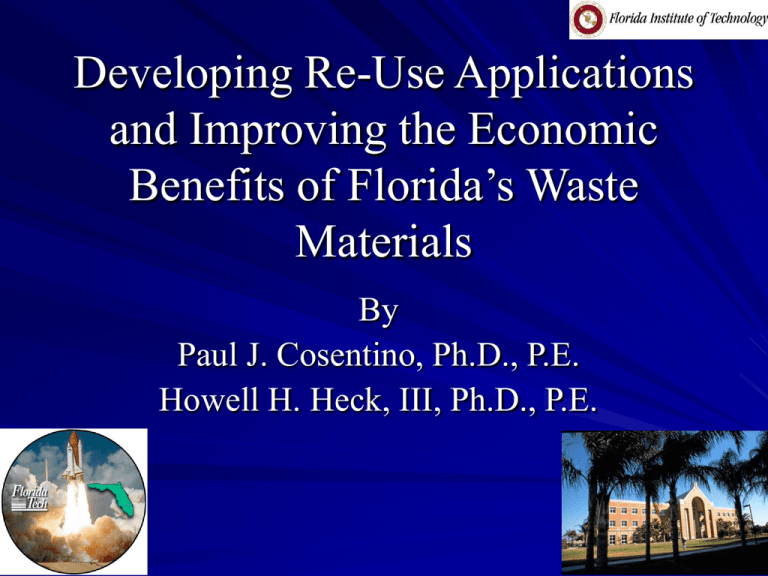
Developing Re-Use Applications and Improving the Economic Benefits of Florida’s Waste Materials By Paul J. Cosentino, Ph.D., P.E. Howell H. Heck, III, Ph.D., P.E. Background Florida stockpiles large volumes of waste or recyclable materials – Examples: Waste Glass RAP Concrete Rubble and Dust Waste-to-Energy Ash – Engineering characteristics of these materials may be improved by adding common fill Background (Cont.) Proper re-use would produce savings for Florida’s construction and landfill industries Florida’s construction boom has caused a large demand for quality fill Engineering properties of RAP improved by adding sand Blending is common practice and often economical Objective Evaluate Florida’s candidate waste materials and improve their engineering behavior by adding conventional fill to make them economically attractive Approach Two year project Nine Tasks to Accomplish Objectives Flow Chart Identify Re-Usable Waste Streams Identify Engineering Environmental and Economic Conditions Sample Waste Materials Accept Dry Rodded Unit Weight Evaluation g Reject Reject Mix % Accept Fundamental Geotechnical Testing and Analysis of Blends Consistency and Economic Impact Accept Reject Reject Landfill Applications Explanation of Tasks 1 – Identify Candidate Waste Materials 2 – Sampling 3 – Fundamental Geotechnical Testing 4 – Analysis of Testing 5 – Waste-Soil Mixing Program 6 – Waste-Soil Geotechnical Testing 7 – Analysis of Mixing Results 8 – Economic Impact of Re-Usable Materials 9 – Reporting, TAG Meetings & Specifications Major Tasks Year 1 – Select candidate materials from facilities statewide – Perform fundamental geotechnical testing – Choose materials with minimal environmental concerns RAP, waste glass and concrete rubble and dust Year 2 – Perform Mixing Analysis – Evaluate Economics – Complete specifications describing proper use Proposed Schedule Expected Technical Results Geotechnical engineering data base Summary of economic impact for re-using these materials Specifications Anticipated Benefits Two end users groups will benefit: – Contractors who use soils and borrow materials in highway construction – Landfill operators at solid waste or construction and demolition landfills Suitable fill is becoming costly. Providing more choices, will control costs and save money. Re-use of waste materials diverts them from the waste stream, and reduces landfilling costs & increases landfill space. Related Work A significant database of information exists to expedite the proposed work Waste products have engineering properties that fall short of those needed for re-use in highways – Waste-to-energy ash – Waste-glass – RAP Follow-up FDOT has funded over a decade work in this area without concentrating on economics. A $261,000 24-month proposal has been funded to continue work on RAP and RAP-soil mixes. The funding request to the FCSHWM is considered a supplement to the FDOT work. Year 1 Budget SALARIES & WAGES PERSON-MONTHS FUNDING GRANTEE FCSHWM + FCSHWM EXTERNAL Paul J. Cosentino PI Howell H. Heck Co-PI Laboratory Technician Graduate Student Undergraduate Students FRINGE BENEFITS (Rate = 23.5 % of Base = $16,240) PERMANENT EQUIPMENT EXPENDABLE SUPPLIES TRAVEL OTHER COSTS Tuition TOTAL PROJECT DIRECT COSTS INDIRECT COSTS ON CAMPUS (Rate = 50% of Base = $ 22,806) OFF CAMPUS (Rate = ___% of Base = $ _______) TOTAL YEAR 1 COSTS PER SOURSE GRAND TOTAL COST PER YEAR 1 1.6 0.4 0.25 10 9 2.5 0.75 11 8 GRANTEE + EXTERNAL $ 12,600 $ $ 3,040 $ 600 $ $ 12,100 $ $ 6,800 $ $ 3,816 $ $ $ 1,000 $ $ 1,750 $ 20,000 $ 10,950 $ $ 52,656 $ 22,365 123,091 1,800 31,680 12,800 7,896 4,000 3,250 7,500 $11,403+ $6,155 $ 52,626 $ 129,246 $64,059+$129,246=$193,305 Year 2 Budget SALARIES & WAGES PERSON-MONTHS FUNDING GRANTEE FCSHWM + FCSHWM EXTERNAL Paul J. Cosentino PI Howell H. Heck Co-PI Laboratory Technician Graduate Student Undergraduate Students FRINGE BENEFITS (Rate = 23.5 % of Base = $16,240) PERMANENT EQUIPMENT EXPENDABLE SUPPLIES TRAVEL OTHER COSTS Tuition TOTAL PROJECT DIRECT COSTS INDIRECT COSTS ON CAMPUS (Rate = 50% of Base = $ 22,806) OFF CAMPUS (Rate = ___% of Base = $ _______) TOTAL YEAR 2 COSTS PER SOURSE GRAND TOTAL COST PER YEAR 2 1.6 0.4 0.25 10 9 3 1.5 11 8 $ $ $ $ $ $ 12,600 3,040 600 12,650 6,800 3,816 GRANTEE + EXTERNAL $ 24,720 $ $ $ $ $ $ $ 1,000 $ 1,750 $ 3,600 31,680 12,800 10,759 2,000 4,500 $ $ 10,950 $ 53,206 $ 18,000 125,521 $11,403+ $6,276 $ 53,206 $ 131,797 $64,609+$131,797=$196,406 Technical Awareness Group & Peer Reviewers David Horhota, Ph.D., P.E. State Geotechnical Materials Engineer, FDOT, david.horhota@dot.state.fl.us John Shoucair Geotechnical Materials Engineer, FDOT, john.shoucair@dot.state.fl.us David Westcott, Technical Service Manager Florida Region, CEMEX Corp., david.westcott@cemexusa.com Chris Brunais, Area Manager, APAC-Florida Melbourne Div. clbrunais@ashland.com Suzanne Boroff FDEP suzanne.boroff@dep.state.fl.us Jim Langenbach, P.E. Senior Engineer, GeoSyntec Consultants, jlangenbach@geosyntec.com Summary Waste Materials can be re-used in Highways Economic Benefits to Construction Industry Economic Benefits to the Solid Waste Industry Environmental Benefits to the Public Questions?
